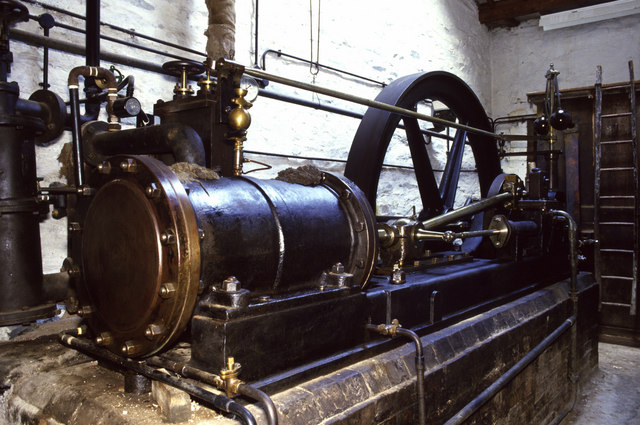
How does a steam engine work? By taking the energy contained in coal and making heat. Then using the heat to turn water into steam and using the steam to push and pull a piston.
The steam engine was the invention that helped push the Industrial Revolution. However, the knowledge of steam power has been around for about two thousand years. Something called the aeolipile was invented in about 50 BC. It is credited to Hero of Alexandria, but there is mention of it at least a hundred years before he lived. It is the first steam engine, although it bears no resemblance to the steam engines invented during the Industrial Revolution. It basically uses jets of steam coming out of nozzles to rotate and doesn’t seem to serve any practical purpose.
The invention of the modern steam engine began in 1606 with the invention of a steam driven pump by Jeronimo de Ayanz y Beaumont. Mines were becoming deeper, and flooding was a serious problem. Ayanz’s invention was aimed at drawing the water out of the mines. However, this was not an engine. It used the power of steam to try to push water out of the mine. Because of this, it had to compete with air pressure and wasn’t very successful. In 1698, Thomas Savery came up with a version that used the pushing and suction power of steam. By this point, atmospheric pressure and the idea of vacuums had been discovered, so he had a slight advantage. When steam condenses, it turns back into water. Water molecules take up much less space when they are a liquid than when they are a gas, and this creates a lower pressure, which is a partial vacuum. Savery’s pump could draw water up to a height of 8 meters but it was also not really an “engine”.
Thomas Newcomen is credited with inventing the first commercially successful steam engine in 1712. It used condensing steam to make a partial vacuum that would pull on a piston. It was stronger than Savery’s pump and could draw water out of even deeper mines. However, it was very inefficient.
Then, along came James Watts. He realized that atmospheric pressure could be used to push the piston back down. Newcomen’s machine used steam to push the piston down and then pull it back up. That meant it needed a constant supply of steam and a constant supply of fuel. Watt’s invention was a separate condensing chamber. In Newcomen’s pump, the steam would be cooled and then reheated. In Watt’s pump, the steam would be condensed in a separate chamber, meaning the pump was more efficient and needed far less steam and fuel.
In 1781, he turned the machine on its side and added a piston that could be pushed from both sides by the steam. Then he added gears and a crank to turn a wheel that could be used with machines. He received financial investment from Matthew Boulton and the Boulton-Watt engine kickstarted the Industrial Revolution.
So, how does a steam engine work? First there has to be a fuel. Most steam engines use coal because it contains a lot of energy for its density. Coal and wood contain the same amount of energy, but coal is far more dense than wood, so, to power a steam engine, you would need a far larger volume of wood.
The coal is burned and the released heat turns water into steam. The steam is fed down pipes to the steam engine where it is contained by a valve. When the valve slides to the side, the steam rushes down into the cylinder and pushes the piston. The steam is then released to the atmosphere. This would only push the piston in one direction and wouldn’t be much use. Two of Watts ideas fixed this. The first is to use steam to push the piston back the other way as well. The valve that keeps the steam out of the cylinder slides back and forth allowing steam into the cylinder on both sides of the piston in order. This allows the piston to be pushed left then right and so on. This alone wouldn’t deliver enough power, so Watt also added a flywheel. The flywheel stores the energy from the piston and allows it to keep moving. There are points in the steam engine cycle where the pistons are not providing force. At these points, the flywheel uses its stored energy to rotate and keeps the engine moving. With everything together, the steam engine will keep running until it runs out of fuel.
The steam engine changed the world. It made mass production possible. A steam engine would be fitted in a factory, and lots of other machines could be run off it. One huge steam engine would have belts running to an overhead shaft that would be connected to lots of other machines. The factory was born. It also allowed the possibility of steam locomotives which changed the way people lived and moved. The first railway was built in 1825 and this ushered in the need for a centralized time system. It also made steam powered cars a thing.
So, how does a steam engine work? By using the pressure of steam to push a piston back and forth. It also requires a flywheel to ensure constant power. And this is what I learned today.
Sources
https://www.thoughtco.com/steam-engines-history-1991933
https://science.howstuffworks.com/transport/engines-equipment/steam1.htm
https://www.livescience.com/44186-who-invented-the-steam-engine.html
https://antonhowes.substack.com/p/age-of-invention-the-spanish-engine
https://www.csmonitor.com/1980/1112/111256.html
https://en.wikipedia.org/wiki/Aeolipile
https://en.wikipedia.org/wiki/Watt_steam_engine
https://en.wikipedia.org/wiki/Steam_engine

Pingback: #411 When was the penny first used? - I Learned This Today